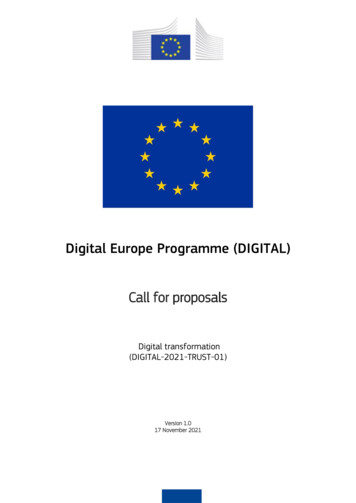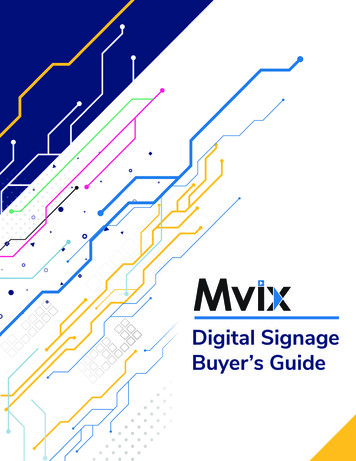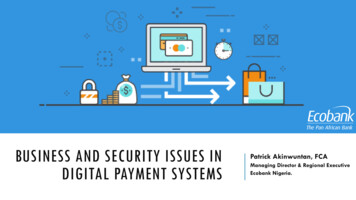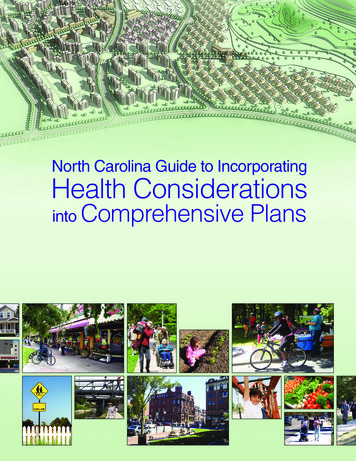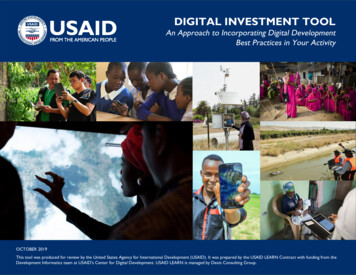
Transcription
DIGITAL INVESTMENT TOOLAn Approach to Incorporating Digital DevelopmentBest Practices in Your ActivityOCTOBER 2019This tool was produced for review by the United States Agency for International Development (USAID). It was prepared by the USAID LEARN Contract with funding from theDevelopment Informatics team at USAID's Center for Digital Development. USAID LEARN is managed by Dexis Consulting Group.
Many USAID activities implement digital systems* to make development more adaptive, efficient, and responsiveto citizens and decision-makers. Using digital systems can help USAID improve the effectiveness and efficiency ofactivities and support partner countries on their journey to self-reliance through increased information sharingand improved government and civil society capacity. Over time, USAID has learned that these investments oftenface predictable challenges that can be addressed at the design phase. The Digital Investment Tool is designed formission staff to ensure that USAID and its implementing partners consider best practices, based on the Principlesfor Digital Development, when developing digital systems.USAID worked with other donors andmultilateral organizations to develop aset of guidelines that help developmentpractitioners integrate best practicesinto digital-enabled programs and avoidcommon missteps. Visitdigitalprinciples.orgThis tool is intended to support work planning, either on a stand-alone activity such as an e-government activity,or on a component of an activity such as a market information system within an agricultural development activity.There are 13 best practice topics, "elements", to select from. Each element contains a scale from Nascent toOptimized. Participants mark where they are and discuss where they would like to be. By providing five stages,we acknowledge that USAID and its partners must often make strategic choices about where to invest their timeand resources—it isn’t all or nothing.The Elements of Digital System Planning:1.2.3.4.5.Development ChallengeLocal OwnershipPolicy LandscapeDigital EcosystemStakeholder Engagement6.7.8.9.System UsersTotal Cost of OwnershipScaleData & Feedback10.11.12.13.Open vs. ProprietaryPrivacy & SecurityReuse & ImprovementChange ManagementThe tool is intended to support a participatory process between USAID, its implementing partners, andstakeholders who are involved in designing, creating proposals for, evaluating, and making purchasing decisions ondigital systems. Ideally, the facilitator will have some technical experience with digital technology. A facilitator’sguide is available at the end of the tool.* A variety of terms may be used to describe digital investments, for example, digital technology, digital solutions, data systems,digital tools, etc. For the purposes of this document all of the aforementioned will be represented by the term digital systems.AcknowledgementsThe content for this tool is based on theUSAID Global Health Bureau’s DigitalHealth Investment Review Tool. Specialthanks to contributors from thatinitiative, the Digital Impact Alliance, andthe digital development community.Cover Photo Credits(Left to right, Top to bottom)Hamesuda Mawilai/USAID; Ed Owles,Worldview; Oussama Benbila forMEC/USAID; Panos; USAID; FreddyFeruzi, Cloudburst Group; SofianQurashi/Water Management Initiative;David Rochkind/USAID
Using the Tool: There are 13 elements to choose from. For each there is a worksheet for maturity assessment and action planning:Maturity Assessment WorksheetAction Planning WorksheetIf the element is prioritized for action planningThe element name and mainissue for consideration.An explanation of why theelement is important to address.The maturity scale gives five stagedescriptions for the element fromNascent to Optimized. Find the stage thatdescribes your level of planning (at theproposal evaluation or design phase) orexecution (at the implementation phase).Mark the stage that most closely matches.Term definitions.Documents that mayinclude informationto help determinethe maturity stage.A space for notes from theconversation, includingevidence or examples thatdemonstrate why a maturitystage was selected.Mark here if thiselement will be a focusfor action planning.Links to additional resources that users can access, includingthose for the relevant Principles for Digital Development.Important probing questions to prompt asecondary level of analysis on the issue.Clickable tabs thatshow whichelement you areon (red) and linkto others (gray).An action planning table to capture decisions reached on: Action ideas: what you commit to in order to address issues raisedin the maturity assessment Next steps: concrete steps to implement the action idea Person(s) responsible: who will be involved in implementation Timeline: the timing (e.g., milestones, deadlines) for each next step
NASCENT No or scant mention ofthe development challengeand how the digital systemaddresses itEMERGING Speaks generically orsuperficially about how thedigital system fits into thebroader development effortESTABLISHED Articulates a case for whythe digital system solvessome or all of thedevelopment challengeADVANCED Articulates a theory ofchange for the developmenteffort that incorporates localperspectives and prioritiesMaturity Assessment Notes Details how the digitalsystem supports thedevelopment effort’s theoryof change and how thatcontribution will be validatedor tested12. Reuse & Improve5. Stakeholders13. Change Mgmt6. System UsersFacilitation Guide7. Cost of OwnershipPriority Area for Action Planning Includes a theory ofchange that is co-createdwith local stakeholders4. Ecosystem Details how the digitalsystem supports that theoryof changeOPTIMIZED3. Policy LandscapeIt is common for technology solutions to be proposed for development problems as if they are a cure-all, but there is not alway sufficient attention to whether the proposed“solutions” actually fit the problems or take into account the issues underlying those problems. Without ensuring that the digital system is appropriate for the problem especiallyas defined by local stakeholders, you run the risk of using technology for its own sake rather than in service of the development outcomes you want.2. Local OwnershipNeeds Assessment, Business Case, orScope of Work1. Dev’t ChallengeUnderstanding the development challenge and how the digitalsystem helps address itA narrative description of how and why a purpose orresult is expected to be achieved in a particularcontext.10. Open/Proprietary 11. Privacy & SecurityMATURITY ASSESSMENT9. Data & FeedbackDefinition: Theory of Change8. Scale1Development Challenge
1. Dev’t Challenge9. Data & Feedback2. Local Ownership10. Open/Proprietary 11. Privacy & Security3. Policy LandscapeRelevant Principles for Digital Development:ACTION PLANNINGDesign with the UserUnderstanding the development challenge and how the digitalsystem helps address itUnderstand the Existing EcosystemBuild for SustainabilityBe CollaborativeSecondary AnalysisA.What is the specific development challenge we are trying to solve? Have the local stakeholdersdefined that challenge?B.Are we solving the right problem? Is it crucial to local stakeholders? Is it crucial to mission strategy?If not either, is there suitable demand to proceed?What is the desired outcome? What’s your vision of success? What’s local stakeholders’ vision ofsuccess? Who stands to benefit and why?D.What about the development challenge makes it suitable to be addressed by a digital system? Whatcould make it unsuitable? How can we deepen our understanding?E.What are the risks of applying a digital system to this challenge? What type of risk is tolerable?NEXT STEP(S)Other Tools and Resources: Tips for Producing Promising DevelopmentHypothesesIntegrating Mobiles into Development ProjectsWHO Guideline: recommendations on digitalinterventions for health system strengtheningPERSON(S)RESPONSIBLETIMELINE4. EcosystemC.ACTION IDEA(S)8. Scale1FOR MORE INFORMATIONDevelopment Challenge12. Reuse & Improve5. Stakeholders13. Change Mgmt6. System UsersFacilitation Guide7. Cost of Ownership
NASCENT No local owner specified No plan to define ongoingresource needs beyonddonor fundingEMERGING Identifies potential localowner(s) Plans to identify resourceneeds beyond donor supportESTABLISHED Identifies the mostappropriate local owner andhas a clear plan to engagethemMaturity Assessment Notes5. Stakeholders6. System Users7. Cost of Ownership Plan for sustainabilityoutlined and agreed upon bylocal ownerFacilitation Guide Plan for sustainabilityoutlined and agreed upon bylocal owner Processes for decisionmaking on strategy, designand implementation will bedriven by the local owner13. Change MgmtPriority Area for Action Planning Processes for decisionmaking on strategy, designwill include participation fromthe local owner If possible, there is aco-creation process and jointimplementation plan withclear roles and milestones12. Reuse & Improve Includes a resource planfor sustainability as adeliverable or milestone wellbefore the end of theinitiative Has plans for a writtenagreement with defined localowner and vendor roles (e.g.,MOU, service-levelagreement)OPTIMIZED4. Ecosystem Identifies general roles ofthe local owner, esp. vis-a-visthe implementing partnerADVANCED3. Policy LandscapeThe design, ownership, and involvement of local and international actors can sustain the learnings and implementation beyond the initial phase. Although this can come withtrade-offs in efficiency, it can greatly increase the system’s chance of being sustained and scaled. Possible local owners may include the host country government’s relevant lineministry, a local CSO, or a private sector actor. The total cost of ownership is critical to consider for local ownership - see Element #7 for more information.2. Local OwnershipStakeholder Engagement Plan,Documentation & Dissemination Plan1. Dev’t ChallengePlanning for sustainable local ownership from the outset10. Open/Proprietary 11. Privacy & SecurityOrganization or entity who will have ultimate controlover the system.MATURITY ASSESSMENT9. Data & FeedbackDefinition: Local owner8. Scale2Local Ownership
8. Scale1. Dev’t Challenge9. Data & Feedback2. Local Ownership10. Open/Proprietary 11. Privacy & Security3. Policy Landscape2FOR MORE INFORMATIONLocal OwnershipACTION PLANNINGRelevant Principles for Digital Development:Understand the Existing EcosystemPlanning for sustainable local ownership from the outsetBuild for SustainabilityBe CollaborativeSecondary AnalysisA.How can local ownership be planned for from the beginning, instead of a hand off at the end of theproject? If complete local ownership from the outset is not possible, how can it be phased in overtime?B.If technical assistance is planned, can technical advisors be embedded within the local institution?C.Is the digital system embedded in the local institution’s IT system? If not, do they have full userrights to view data and administer the system? Are programmers working in partnership with theinstitutions IT team?D.Does the local owner have the capacity to administer and maintain the system? If not, are thereplans to develop or ensure their capacity to do so?NEXT STEP(S) Problem-Driven Iterative Adaptation (PDIA) andBuilding State Capacity Video SeriesInveneo’s ICT Sustainability PrimerPERSON(S)RESPONSIBLETIMELINE4. EcosystemACTION IDEA(S)Other Tools and Resources:12. Reuse & Improve5. Stakeholders13. Change Mgmt6. System UsersFacilitation Guide7. Cost of Ownership
NASCENT No or scant mention oflocal policies or guidelinesEMERGING Mentions relevant policiesand guidelinesESTABLISHED Includes a plan to reviewexisting guidelines andpolicies Details current andplanned revisions to policiesand guidelines and how thismay influence system in thefuture12. Reuse & Improve5. Stakeholders13. Change Mgmt6. System UsersFacilitation Guide7. Cost of OwnershipPriority Area for Action Planning Details relevant policiesand guidelines and how theywill influence the systemdesign and implementationOPTIMIZED4. EcosystemMaturity Assessment NotesADVANCED3. Policy LandscapeDigital systems designed without understanding of local policies will be limited in their ability to scale beyond small pilots and may be in violation of existing governmentstandards or policies. These policies may be at the national, state, and/or district level, as appropriate. There may also be relevant sector or geographic-specific ICT plans.2. Local OwnershipLandscape Analysis1. Dev’t ChallengeAccounting for relevant local ICT policies, guidelines, andstrategic plansInformation and Communication Technology (ICT) isthe technology that stores, retrieves, manipulates,transmits and/or receives information electronicallyin a digital form.10. Open/Proprietary 11. Privacy & SecurityMATURITY ASSESSMENT9. Data & FeedbackDefinition: ICT8. Scale3Policy Landscape
2. Local Ownership3. Policy LandscapeUnderstand the Existing EcosystemBe CollaborativeWhat relevant local data, ICT, and intellectual property policies and regulations exist, includingfrom different levels of government, and how do they constrain or enable the system? How willthose policies and regulations be addressed? Are there planned policy changes that may affect thedigital system?Are there any cross-government initiatives to coordinate ICT and data use? How should these beengaged?Are there technical working groups or other coordinating mechanisms across government, civilsociety, and other implementing organizations who inform policy development that you want toengage? How will you engage them?NEXT STEP(S)Other Tools and Resources: Relevant Questions for External Stakeholders(Government Ministries section) in the DigitalDevelopment Playbook Country/Regional StrategicPlanning section (USAID only)Thinking and Working Politically (TWP) throughApplied Political Economy Analysis (PEA)PERSON(S)RESPONSIBLETIMELINE4. EcosystemACTION IDEA(S)1. Dev’t ChallengeDesign with the UserSecondary AnalysisC.10. Open/Proprietary 11. Privacy & SecurityRelevant Principles for Digital Development:Reuse and ImproveB.9. Data & FeedbackACTION PLANNINGAccounting for relevant local ICT policies, guidelines, andstrategic plansA.8. Scale3FOR MORE INFORMATIONPolicy Landscape12. Reuse & Improve5. Stakeholders13. Change Mgmt6. System UsersFacilitation Guide7. Cost of Ownership
NASCENT No or scant mention ofother relevant ICT systemsEMERGINGESTABLISHEDADVANCED Builds upon global ICTstandards, platforms andtools Builds upon global ICTstandards, platforms andtools Includes a plan to reviewthe local digital ecosystem Includes a plan to reviewthe local digital ecosystem Identifies the localinstitutions, communities,platforms, and projects thatare relevant to the initiativeand its digital systemsMaturity Assessment Notes Mentions other relevantlocal ICT systems andinstitutions5. Stakeholders13. Change Mgmt6. System UsersFacilitation Guide7. Cost of Ownership Clearly assesses the localdigital ecosystem, includinglocal providers, use ofexisting standards, platformsand tools, and its impact oninteroperability, reuse, andadaptation strategies12. Reuse & ImprovePriority Area for Action Planning Builds upon andcontributes back to globalICT standards, platforms andtools4. Ecosystem Considers global ICTstandards, platforms andtoolsOPTIMIZED3. Policy LandscapeInterventions designed without understanding the digital ecosystem may duplicate existing efforts or not properly leverage existing platforms, data, and registries. This may resultin wasted money, limit data sharing opportunities, and contribute to a fragmented ecosystem. Local providers and institutions are essential parts of the digital ecosystem. ExistingICT systems and data sources are also important elements of the ecosystem to consider (including those that are supported by external entities, e.g., DHIS2 or Microsoft).2. Local OwnershipLandscape Analysis1. Dev’t ChallengeUnderstanding the global and the local digital ecosystemsThe culture, gender norms, political environment,economy, technology infrastructure, and otherfactors that can affect an individual’s ability to accessand use a technology or to participate in an initiative.10. Open/Proprietary 11. Privacy & SecurityMATURITY ASSESSMENT9. Data & FeedbackDefinition: Ecosystem8. Scale4Digital Ecosystem
2. Local Ownership3. Policy LandscapeUnderstand the Existing EcosystemSecondary AnalysisBe CollaborativeWhat local, regional, and global institutions, networks, communities, platforms, and projects arerelevant to the target users and digital systems of your initiative?B.Does the initiative recognize how people informally operate within their systems and political andorganizational cultures? Will local markets and cultural practices sustain digital systems required byyour initiative?C.What existing local and global technology and data standards, infrastructure, platforms, and toolsare being used by your target population, in your geography, or in your sector? Can your initiativeintegrate with or extend these existing efforts? Also see Elements #10 and #12.NEXT STEP(S)Other Tools and Resources: Relevant Questions for External Stakeholders(sections for Private Sector / Non-GovernmentalOrganizations and Development Partners / Donors)under Principles for Digital Development PlaybookCountry/Regional Strategic Planning (USAID only)PERSON(S)RESPONSIBLETIMELINE4. Ecosystem1. Dev’t Challenge10. Open/Proprietary 11. Privacy & SecurityRelevant Principles for Digital Development:Use Open Data, Open Standards, OpenSource, Open InnovationACTION IDEA(S)9. Data & FeedbackACTION PLANNINGUnderstanding the global and the local digital ecosystemsA.8. Scale4FOR MORE INFORMATIONDigital Ecosystem12. Reuse & Improve5. Stakeholders13. Change Mgmt6. System UsersFacilitation Guide7. Cost of Ownership
ESTABLISHED Identifies key stakeholders Identifies key stakeholders Has identified onlydissemination opportunitiesor local stakeholders Has a partial plan toengage (often during thebeginning or end of aninitiative)Maturity Assessment NotesOPTIMIZED Identifies all relevantdirect and indirectstakeholders Identifies all relevantdirect and indirectstakeholders Has plan to regularlyengage them during all cyclesof the initiative Shows understanding ofneeds and motivations ofthese groups and has plan toaddress them5. Stakeholders13. Change Mgmt6. System UsersFacilitation Guide7. Cost of Ownership Has plan to regularlyengage them during all cyclesof the initiative, includingplans to document and sharelessons learned,programmatic and technologyapproaches, code andtechnical documentation12. Reuse & ImprovePriority Area for Action PlanningADVANCED4. Ecosystem3. Policy Landscape No or scant mention ofstakeholdersEMERGING2. Local OwnershipStakeholder Engagement PlanSuccessful initiatives will identify groups beyond the initial systems users, engage them throughout the initiative development lifecycle, and seek to contribute resources back tothe broader stakeholder community. Understanding and addressing stakeholder needs and concerns early and communicating consistently can improve likelihood of support.NASCENT1. Dev’t ChallengeEngaging key stakeholders effectively10. Open/Proprietary 11. Privacy & SecurityAny group or individual which can affect or isaffected by an initiative, activity or organization.MATURITY ASSESSMENT9. Data & FeedbackDefinition: Stakeholder8. Scale5Stakeholder Engagement
8. Scale1. Dev’t Challenge9. Data & Feedback2. Local Ownership10. Open/Proprietary 11. Privacy & Security3. Policy Landscape5FOR MORE INFORMATIONStakeholder EngagementACTION PLANNINGRelevant Principles for Digital Development:Design with the UserEngaging key stakeholders effectivelyUnderstand the Existing EcosystemDesign for ScaleSecondary AnalysisBuild for SustainabilityA.How and at what points in the initiative’s lifecycle will you engage the stakeholders? What level ofparticipation or formal sign off will be best? How will you articulate the value of their perspective?What concrete products and processes will be used to collaborate and contribute locally?B.Are there other stakeholders that are relevant to the initiative? For example, have you contactedmobile network operators; the local Ministry of Information, Communication, and Technology;USAID mission staff such as the STIP POC, data steward?C.Is anyone else trying to solve this problem? How are they attempting to do this? Couldcollaboration help? Should we collaborate with them?D.Who may oppose the system, e.g., doctors who may oppose letting nurses use decision supporttools or agriculture price setters who might lose out if farmers could access crop prices? How willyou engage them?NEXT STEP(S)Other Tools and Resources: USAID’s Innovation Design and Advisory (iDesign)(USAID only)USAID A&A Labs Co-Creation Toolkit (USAID only)Stakeholder mapping and analysis resourcesPERSON(S)RESPONSIBLETIMELINE4. EcosystemACTION IDEA(S)Be Collaborative12. Reuse & Improve5. Stakeholders13. Change Mgmt6. System UsersFacilitation Guide7. Cost of Ownership
ESTABLISHEDADVANCEDOPTIMIZED Identifies potential systemsusers Identifies potential systemsusers Identifies potential systemsusers Plans to engage users aspart of a needs assessment Plans to actively involverelevant users during thedesign Plans to actively involverelevant users during thedesign, deployment, andmaintenance phases Demonstrates clearunderstanding of user needsand workflows and detailsplan to support users toadapt to any new practices12. Reuse & Improve5. Stakeholders13. Change Mgmt6. System UsersFacilitation Guide7. Cost of OwnershipPriority Area for Action Planning Clearly describes plannedco-creation approaches withusers during the design,deployment, and maintenancephases4. Ecosystem Identifies potential systemsusersMaturity Assessment Notes3. Policy Landscape No or scant description ofsystems users or plan toengage themEMERGING2. Local OwnershipStakeholder Engagement PlanFailure to understand and involve a system’s users is one of the top reasons that ICT systems fail to reach their potential. Understanding users and getting their feedbackthroughout the implementation timeline will result in a tool that is more usable, has a greater chance of being adopted, and will increase user ownership of the system.NASCENT1. Dev’t ChallengeDesigning and implementing a digital system that addresses theneeds of system users10. Open/Proprietary 11. Privacy & SecurityPeople who will interact directly with the toolor system.MATURITY ASSESSMENT9. Data & FeedbackDefinition: System User8. Scale6System Users
1. Dev’t Challenge9. Data & Feedback2. Local Ownership10. Open/Proprietary 11. Privacy & Security3. Policy LandscapeACTION PLANNINGRelevant Principles for Digital Development:Design with the UserDesigning and implementing a digital system that addresses theneeds of system usersUnderstand the Existing EcosystemDesign for ScaleBuild for SustainabilitySecondary AnalysisBe CollaborativeA.Who are the system users? How will you develop an understanding of their abilities (e.g., userprofiles, focus groups, testing, and iterating)?B.How can the system be adapted around users, rather than forcing users to accommodate thesystem? C.How will you develop an understanding of the incentives of the system users and take them intoaccount in the design process? D.How are the system’s technical requirements driven by data and decision needs related to thedevelopment intervention?NEXT STEP(S)Other Tools and Resources:USAID’s Innovation Design and Advisory(iDesign)(USAID only)IDEO’s Field Guide to Human-Centered DesignPERSON(S)RESPONSIBLETIMELINE4. EcosystemACTION IDEA(S)8. Scale6FOR MORE INFORMATIONSystem Users12. Reuse & Improve5. Stakeholders13. Change Mgmt6. System UsersFacilitation Guide7. Cost of Ownership
NASCENT No costs included beyondinitial stageEMERGING Includes costs for vendorto support maintenanceESTABLISHED Includes costs to supportmaintenance, and hasconsiderations for thesystem’s long-term ownershipby government orappropriate local party Identifies a plan toresource long-termownership7. Cost of Ownership Identifies potential sourcesof funds to support long-termownership6. System Users Includes costs of initial andperiodic supportivesupervision or training ofgovernment staff andestablishment of appropriatehosting environment5. Stakeholders Includes costs of initial andperiodic supportivesupervision or training ofgovernment staff andestablishment of appropriatehosting environmentFacilitation Guide Includes costconsiderations for thesystem’s long-term ownershipby government orappropriate local party13. Change Mgmt Includes costconsiderations for thesystem’s long-term ownershipby government orappropriate local party12. Reuse & ImprovePriority Area for Action PlanningOPTIMIZED4. EcosystemMaturity Assessment NotesADVANCED3. Policy LandscapeClear identification of costs for implementation, operation, and maintenance are critical so that an institution can have a clear view as to what resources are required to supporta system long-term (e.g., beyond the life of USAID funding). Without this, local ownership is often not possible, and systems maintenance or hardware upgrades may not beavailable.2. Local OwnershipBudget1. Dev’t ChallengePlanning for the full costs of designing, operating, and maintainingthe system over its lifetimeThe costs of the system, including software as well asthe necessary hardware, and hosting and supportover the lifetime of the system.10. Open/Proprietary 11. Privacy & SecurityMATURITY ASSESSMENT9. Data & FeedbackDefinition: Total Cost of Ownership8. Scale7Total Cost of Ownership
1. Dev’t Challenge9. Data & Feedback2. Local Ownership10. Open/Proprietary 11. Privacy & Security3. Policy LandscapeACTION PLANNINGRelevant Principles for Digital Development:Design for ScalePlanning for the full costs of designing, operating, and maintainingthe system over its lifetimeBuild for SustainabilityOther Tools and Resources:Secondary Analysis A.What is the intended sustainability for the initiative (time-bound, transition to maturity sustainingor commercial model, long-term ownership by other entity)? Also see Element #6.B.Are there plans to develop or ensure the long-term owner’s capacity to operate and maintain thesystem?C.Does the budget include implementation costs such as system configuration and deployment,training, user testing, and transaction, service, or licensing fees?D.Does the budget account for scaling costs, replacement of equipment, and ongoing administrationand maintenance such as system upgrades, bug fixes, etc.?NEXT STEP(S) USAID Digital Development Playbook: Budget (USAIDonly)Common Cost Elements Associated with DigitalTechnologies (USAID only)PERSON(S)RESPONSIBLETIMELINE4. EcosystemACTION IDEA(S)8. Scale7FOR MORE INFORMATIONTotal Cost of Ownership12. Reuse & Improve5. Stakeholders13. Change Mgmt6. System UsersFacilitation Guide7. Cost of Ownership
Defines intended scaleESTABLISHEDADVANCEDOPTIMIZED Defines intended scale Defines intended scale Articulates changes thatmay need to be made as scaleincreases Articulates changes thatmay need to be made as scaleincreases Articulates changes thatmay need to be made as scaleincreases Provides clear budgetfigures to support Provides clear budgetfigures to support12. Reuse & Improve5. Stakeholders13. Change Mgmt6. System UsersFacilitation Guide7. Cost of OwnershipPriority Area for Action Planning Defines changes to rolesand responsibilities of allstakeholders at scale4. Ecosystem Defines intended scaleMaturity Assessment Notes3. Policy Landscape Does not define intendedscaleEMERGING2. Local OwnershipBudgetFailure to account for scale may limit the ability to support user needs of the system and may result in an inability to adapt the system to accommodate expansion. The strategiesfor support and maintenance of systems may vary at different levels of scale. Technological components, e.g., hardware, software, bandwidth, etc., may need to be changed asusage, numbers of clients, users, and connections increase. Capacity building and system support activities may need to be built into the budget and schedule as the scale changes.NASCENT1. Dev’t ChallengeDefining intended scale of the digital system and how implementationand maintenance support may vary at different levels of scaleA definition of what widespread adoption looks likefor the context—percentage of population, numberof users and/or geographic reach.10. Open/Proprietary 11. Privacy & SecurityMATURITY ASSESSMENT9. Data & FeedbackDefinition: Scale8. Scale8Scale
1. Dev’t Challenge2. Local Ownership10. Open/Proprietary 11. Privacy & Security3. Policy LandscapeRelevant Principles for Digital Development:Design for ScaleBuild for SustainabilityBe CollaborativeSecondary AnalysisOther Tools and Resources:Could collaboration with other institutions or development projects or activities in the country orregion increase scale of the digital system? What about technology companies or private sectorpartners?B.Can you identify a phased approach to reach your projected scale?C.Have you reviewed your activity to identify which components can be scaled as-is and which willneed to be adapted or upgraded as scale or scope increases?D.Have you identified risks for scaling and developed mitigation plans to address them?ACTION IDEA(S)9. Data & FeedbackACTION PLANNINGDefining intended scale of the digital system and how implementationand maintenance support may vary at different levels of scaleA.8. Scale8FOR MORE INFORMATIONScaleNEXT STEP(S) Beyond Scale: How to make your digital developmentprogram sustainableHow to Calculate Total Lifetime Costs of EnterpriseSoftware SolutionsIntegrating Mobiles into Development ProjectsTIMELINE4. EcosystemPERSON(S)RESPONSIBLE12. Reuse & Improve5. Stakeholders13. Change Mgmt6. System UsersFa
face predictable challenges that can be addressed at the design phase. The Digital Investment Tool is designed for mission staff to ensure that USAID and its implementing partners consider best practices, based on the Principles for Digital Development, when developing digital systems.






